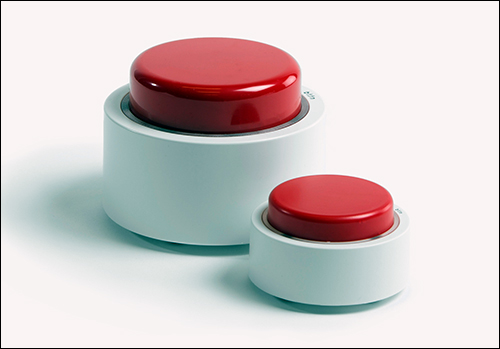At some point when trying to accomplish some task, most everyone has thought, “I just wish there was a button I could press to….” Finnish entrepreneur and industrial designer Harri Koskinen had that thought. He wanted to devise a way for his elderly mother to quickly and easily let her children know when she was lonely or needed something. So he considered devising a button that, when pressed, would trigger a simple command to appear as an SMS text message on his cell phone and those of all his siblings: “Call your mother.”
But Koskinen soon realized that such a device could have many uses. In 2014, he expanded this idea and launched a startup called Bttn. The company markets the device, which is available in two sizes and connects to Bttn’s cloud service via a Wi-Fi connection, a cellular network or an integrated Sigfox low-power wide-area network (LPWAN) radio, for both consumer and commercial uses. For example, taxi companies in Europe and the United States have purchased Bttn devices and installed them in hotels to enable guests to hail a cab by simply pressing the button (once pressed, the button displays a message in response, confirming the order and giving an estimated wait time).

This month, Bttn announced a partnership with Telia, a Swedish telecommunications provider. Telia has launched a new service dubbed “the Personal Technician,” based on the Bttn, for its small and midsize business customers. Telia’s customers can press the button to receive help with IT issues.
When the button is pressed, a Telia representative will call the customer to whom the button was issued and attempt to help him or her solve the problem via telephone. If the representative determines that the issue requires a visit from a technician, one will be dispatched.
Telia does not charge its customers for the service, and says that most IT issues can be resolved over the phone. The Bttn device simply makes it quick and easy for the customer to summon a call from a Telia representative. There are, in some cases, fees associated with technician visits to a customer’s office, but those are irrespective of the Bttn’s use.
Patrik Granström, who heads Telia’s small and midsize business group, says Telia officially launched the Bttn service on Sept. 1 and is beginning to assign Bttns to customers who request them.
Bttn offers two versions of its product. The Bttn Classic, the original model, is just shy of 3 inches in height and 4 inches in diameter, while the newer Bttn Mini measuers 1.57 inches tall with a 2.72-inch diameter. Either model is available with an integrated 2G GPRS cellular modem, or a 2.4 GHz 802.11b/g/n Wi-Fi modem. In Europe, Bttn also offers a version of the product with an integrated Sigfox (868 MHz) radio that transmits data over Sigfox’s LPWAN.
Telia sends its participating customers Bttns with cellular modems that are already provisioned to its network. In that way, all customers need to do, once they receive the device, is power it on.
When adding a Bttn to a Wi-Fi network, customers locate the Bttn’s Wi-Fi signal through a computer’s internet browser and key in their network name and password to connect the device. In Bttn’s cloud-based software, the user associates the Bttn’s unique identifier with a set of instructions. In Telia’s case, the technician receives instructions to call the person to who the Bttn was commissioned.
The Classic model runs on four disposable AA alkaline batteries that have a lifecycle of between 800 and 1,000 pushes of the button when a Wi-Fi connection is used, says Jay Gross, Bttn’s managing director, noting that AA lithium batteries last for up to 10,000 pushes when communicating via Wi-Fi. The Mini version runs either on rechargeable lithium-polymer battery, which lasts for up to 10,000 pushes when used via Wi-Fi, or through a micro-USB charger.
“We don’t hold any information on the button,” Gross explains. “The button itself is not ‘smart’—it’s just a trigger that sends a message to our cloud.”
In France, taxi company Les Taxis Bleus, which operates a fleet of more than 3,000 vehicles, purchases Bttns and issues them to hotels, so that guests looking for a taxi can request one from the concierge, who pushes the Bttn. “If we put them out in the open,” Gross says, “we’d have trouble with children passing by and pressing the buttons.”
One short press engages the Bttn to trigger whatever instructions are assigned to its unique ID nuber. But users can cancel an order by pushing the button a second time and holding it down for three seconds. A green LED indicates that the order has been cancelled.
Rather than selling its hardware, Bttn uses a software-as-a-service business model, under which users pay a monthly fee. If the button transmits over a cellular network, the user also pays cellular subscription fees. In addition, Bttn sells its products directly to consumers, who can use third-party software such as IFTT to program them with reminders or alerts. For example, one could give a Bttn to an aging parent and ask that he or she push the button every time he or she takes medication. If the button is not pushed by a set time, the caretaker or child can receive a text alert.

